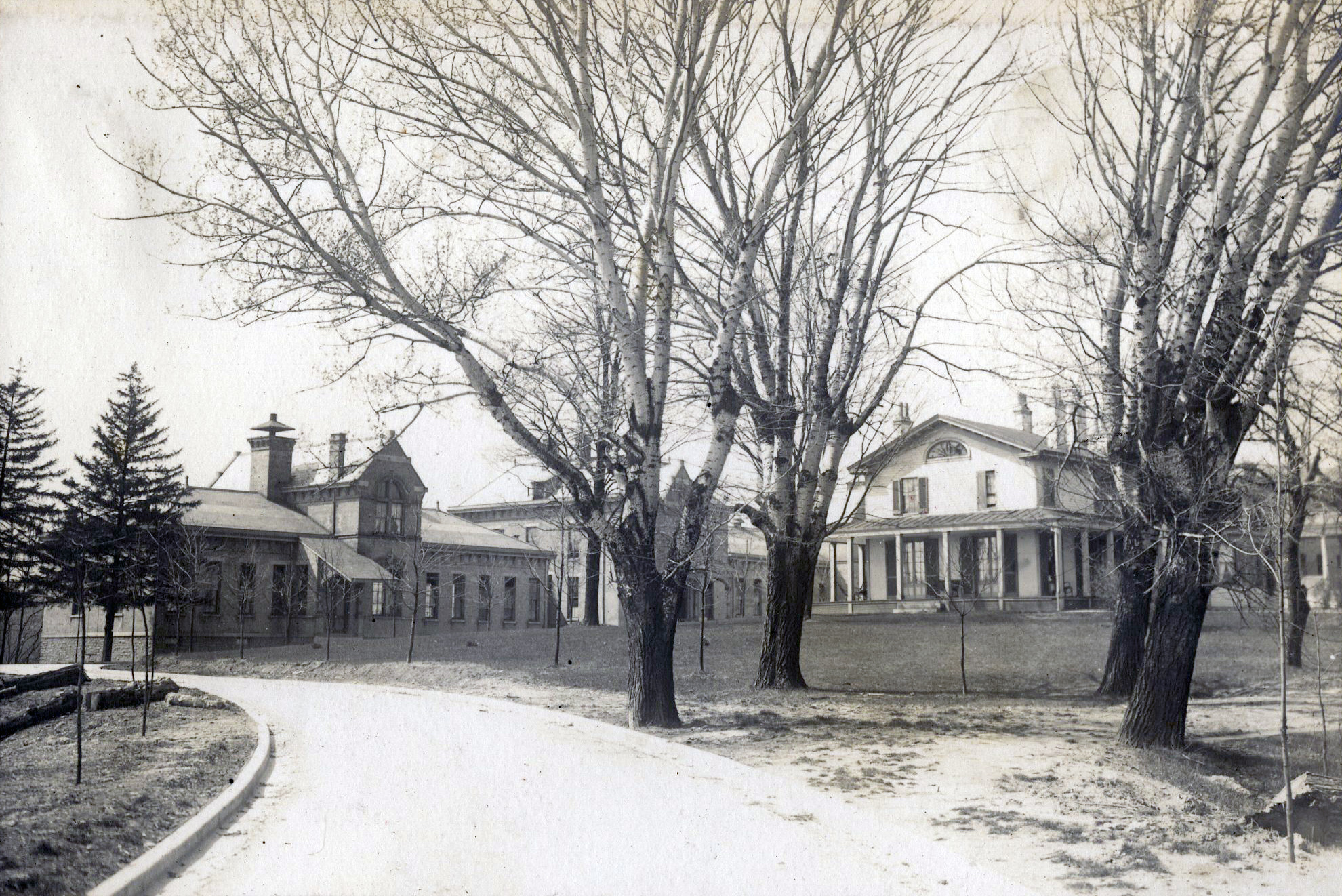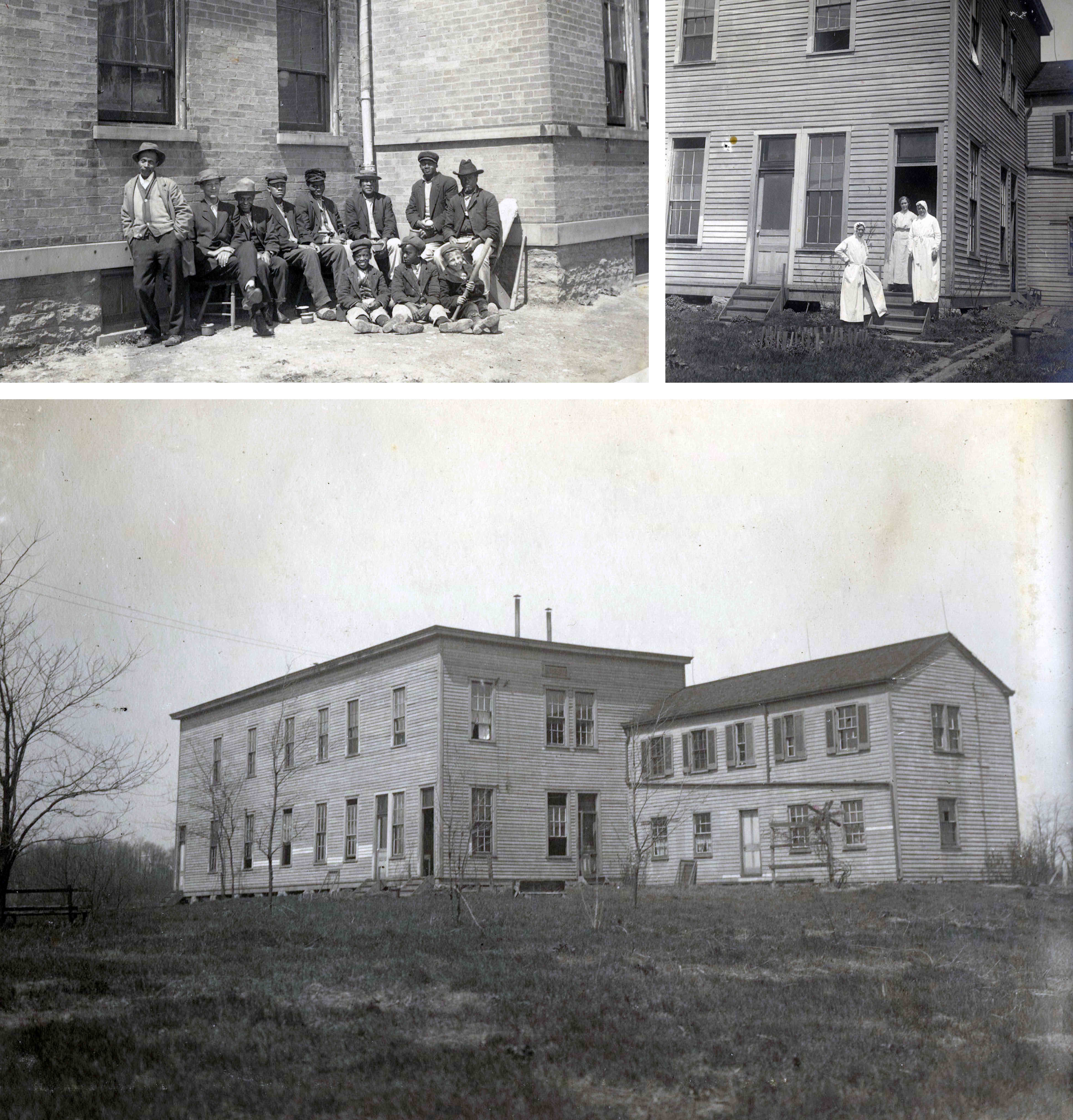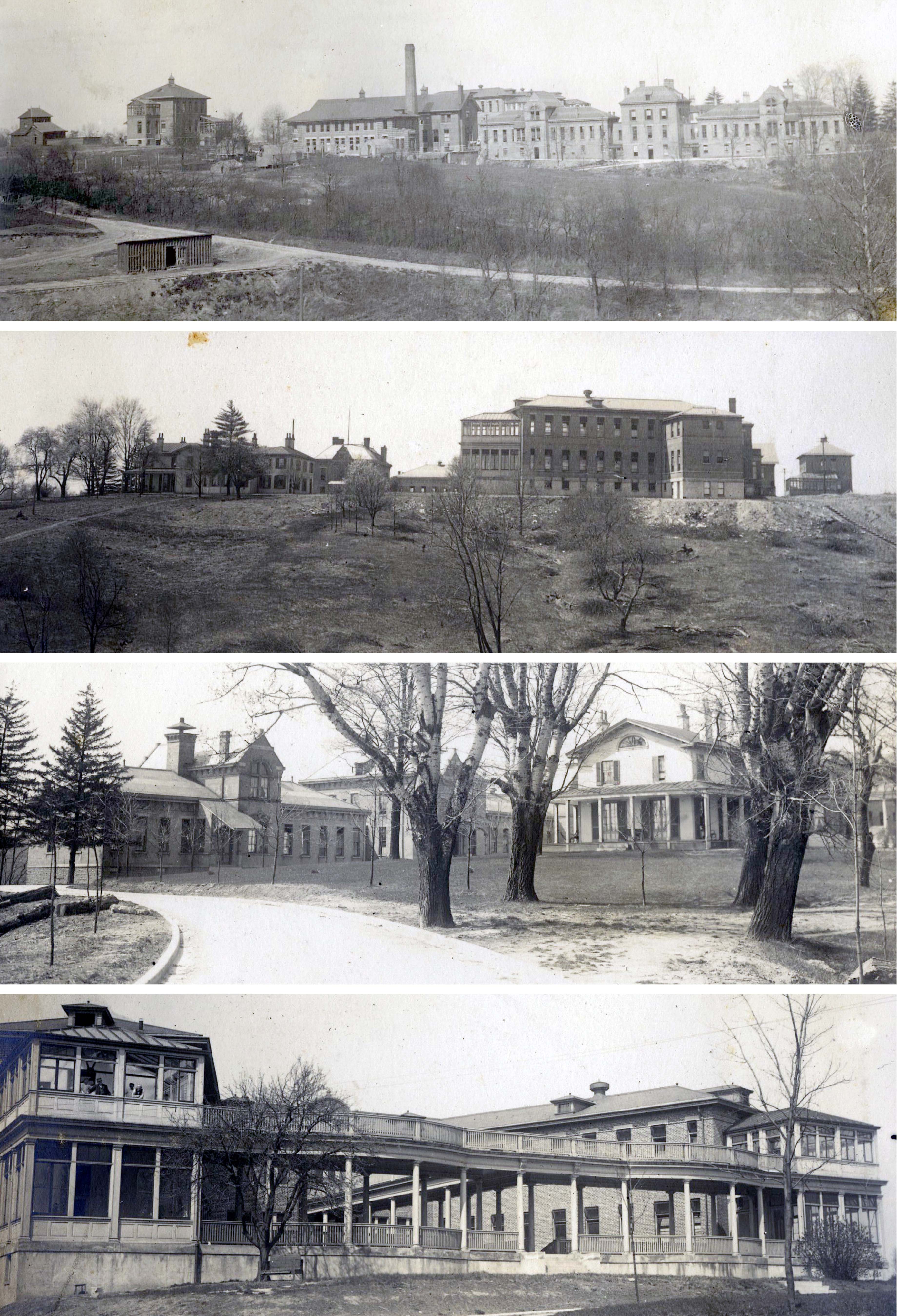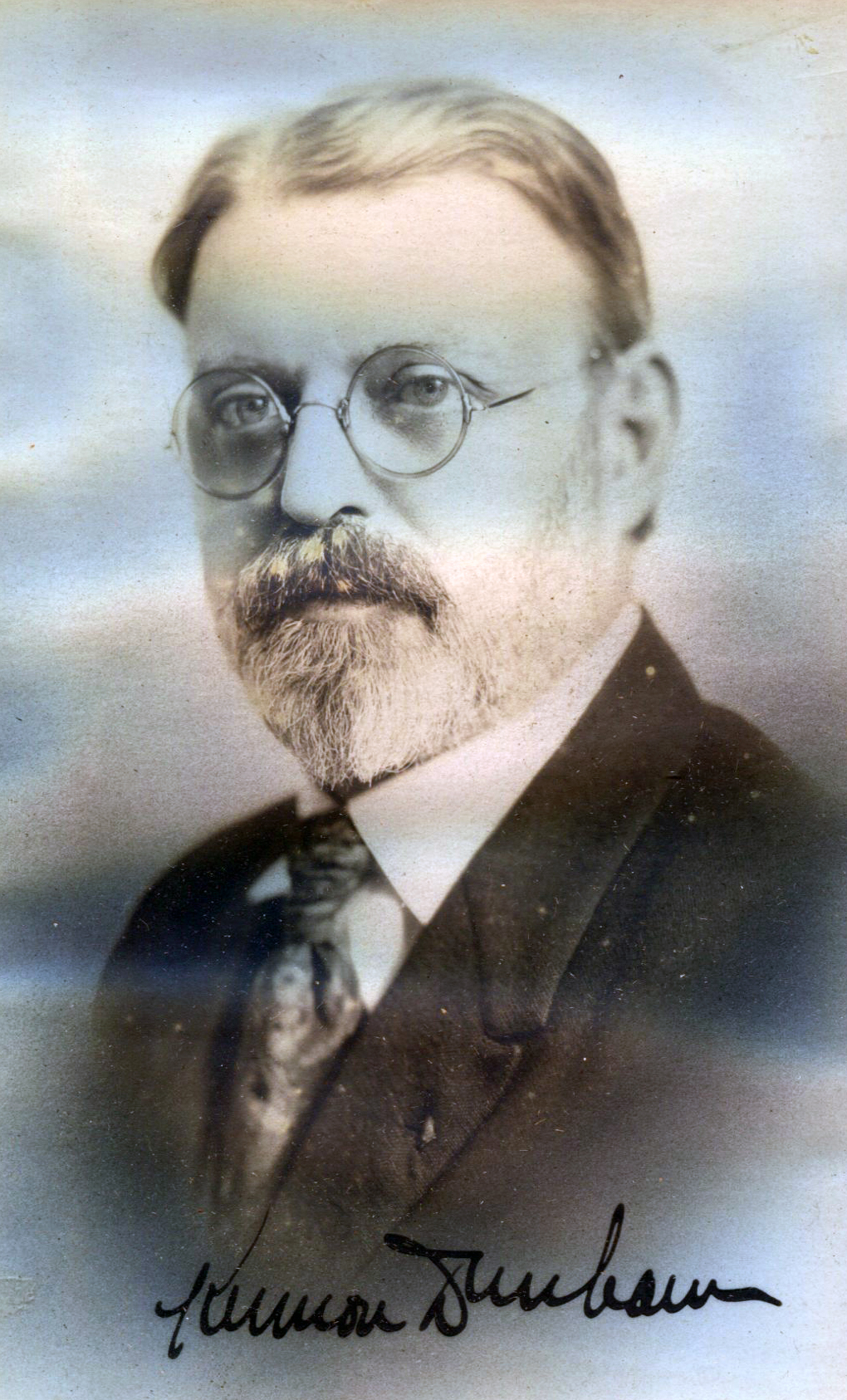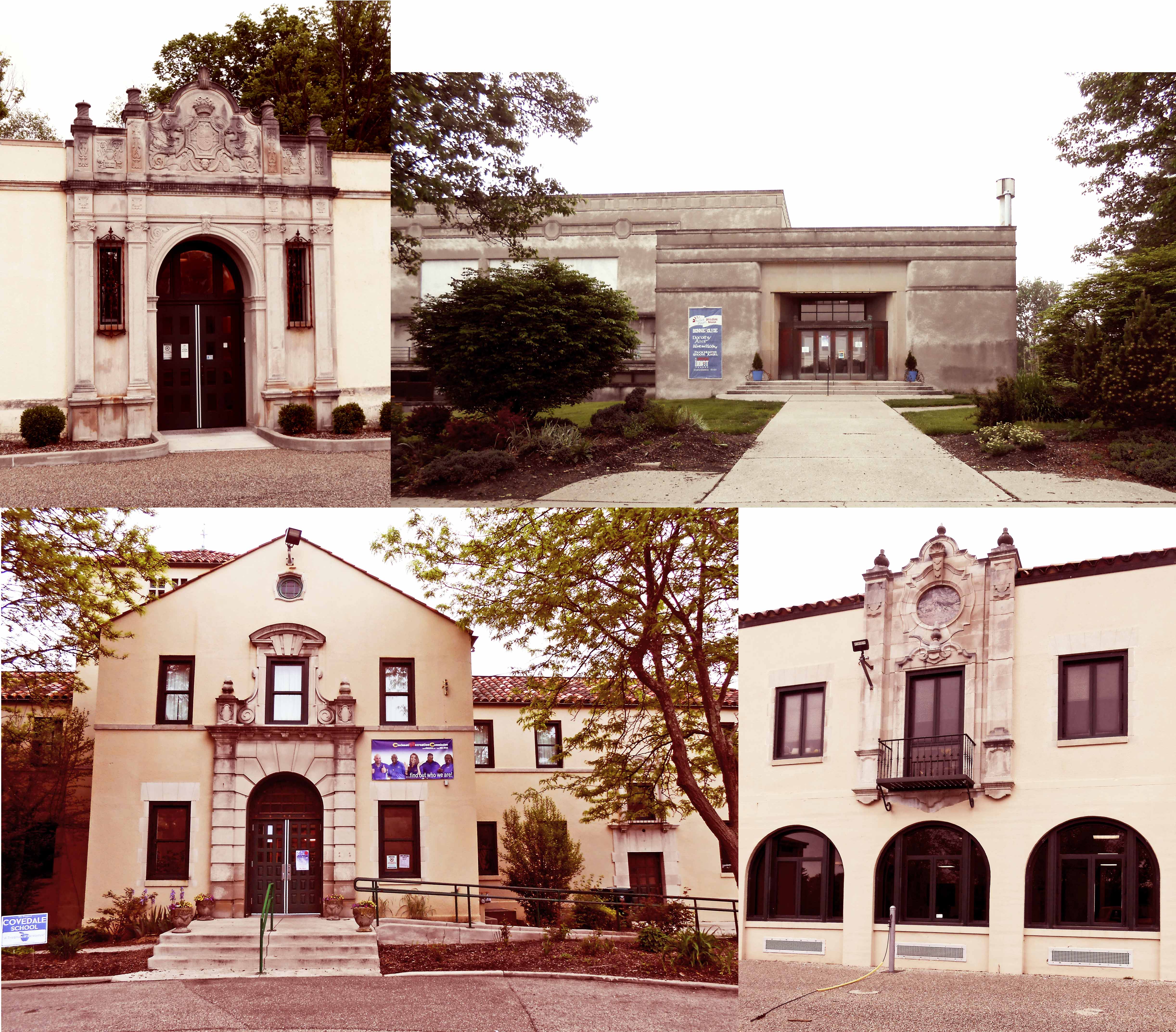
Inscription and tuberculosis symbol from the
stone entrance to Dunham Hospital.
This photo serves as a link to the finding aid for the Cincinnati Branch Tuberculosis (Dunham)
Hospital Collection.
By: Nathan Hood
A few miles west of downtown Cincinnati is the Dunham Recreation Center: a significant expanse of land mostly open to the public. The land however, was not always recreational; at one time it was the location of the Dunham Hospital – the same hospital after which the Center is named. Now long since abandoned, Dunham Hospital was once a branch of the Cincinnati Hospital and a means of treating as well as quarantining tuberculosis patients. But such facts are only a small portion of this institution’s rich history! Indeed, the hospital’s story arguably begins sometime during the early 1800’s.
…an ordinance prepared in 1816 prescribed that such an institution (an ‘Isolation Hospital or “Pest-house…”‘) for the care of persons suffering from small-pox should be provided. – University of Cincinnati College of Medicine Centennial Number, 1920.
Up until provisions were made (presumably) sometime in the 1830’s for the kind of institution described above, the antecedent of the institution in question was located at the site currently occupied by the Cincinnati Music Hall. It appears that attending staff at the time feared the exposure of small-pox patients to the general body of the hospital.
Thus an isolation house was eventually built sometime during the 40’s on the land now occupied by Lincoln Park – it remained there until property on Rohs Hill was acquired in 1963. Today, the new location would be somewhere west of Clifton Avenue but south of McMillian Street. Regardless, after construction at the site was completed, the institution was named the “Rohs Hill Branch” – actually the first name documented referring to this organization in the organization’s recorded history at the Winkler Center. It happened that shortly after the hospital was completed, Cincinnati experienced a series of small-pox epidemics between the years 1863 and ’78. The Rohs Hill Branch treated many of those afflicted as well as six cases of yellow fever in 1878. (The first patient of yellow fever was reported as the second indigenous case of the illness ever recorded in the city.) Eventually, for unknown reasons, the institution was relocated yet again; this time settling much further from downtown Cincinnati.
In 1879 the Gurley farm, in Green Township, Hamilton County, then west of the city limits, in the locality known as Lick Run, was purchased. The farm consisted of fifty-three acres, and cost $19,935. – University of Cincinnati, College of Medicine Centennial Number, 1920.
A new building was constructed there and then outfitted with the necessary equipment at the cost of $33,419. During construction and the transfer from Rohs Hill, Cincinnati was remarkably free of small-pox outbreaks. The Rohs Hill land was eventually sold and the re-located institution was renamed the “Branch Hospital for Contagious Diseases.”
In 1897, the Branch was renovated [and] the farm-house on the site [was] remodeled as an Isolation Hospital. – University of Cincinnati, College of Medicine, Centennial Number, 1920.
Perhaps in-coincidentally, 1897 also saw the transfer of fifteen tuberculosis patients from the Cincinnati Hospital (now the University Hospital). Construction began again and 1909 saw the opening of two new buildings: Building No. 2 and Building No. 3. The institution simultaneously began building a necessary extension to the hospital’s power plant. The total cost of these additions amounted to $287,000. Around this time, Building No. 3 was constructed “in the depression between two hills” and “intended as a ‘Variola Hospital.’” Under the direction of Dr. Rockhill in 1911, this hospital building came into use as another area for the treatment of pulmonary tuberculosis.
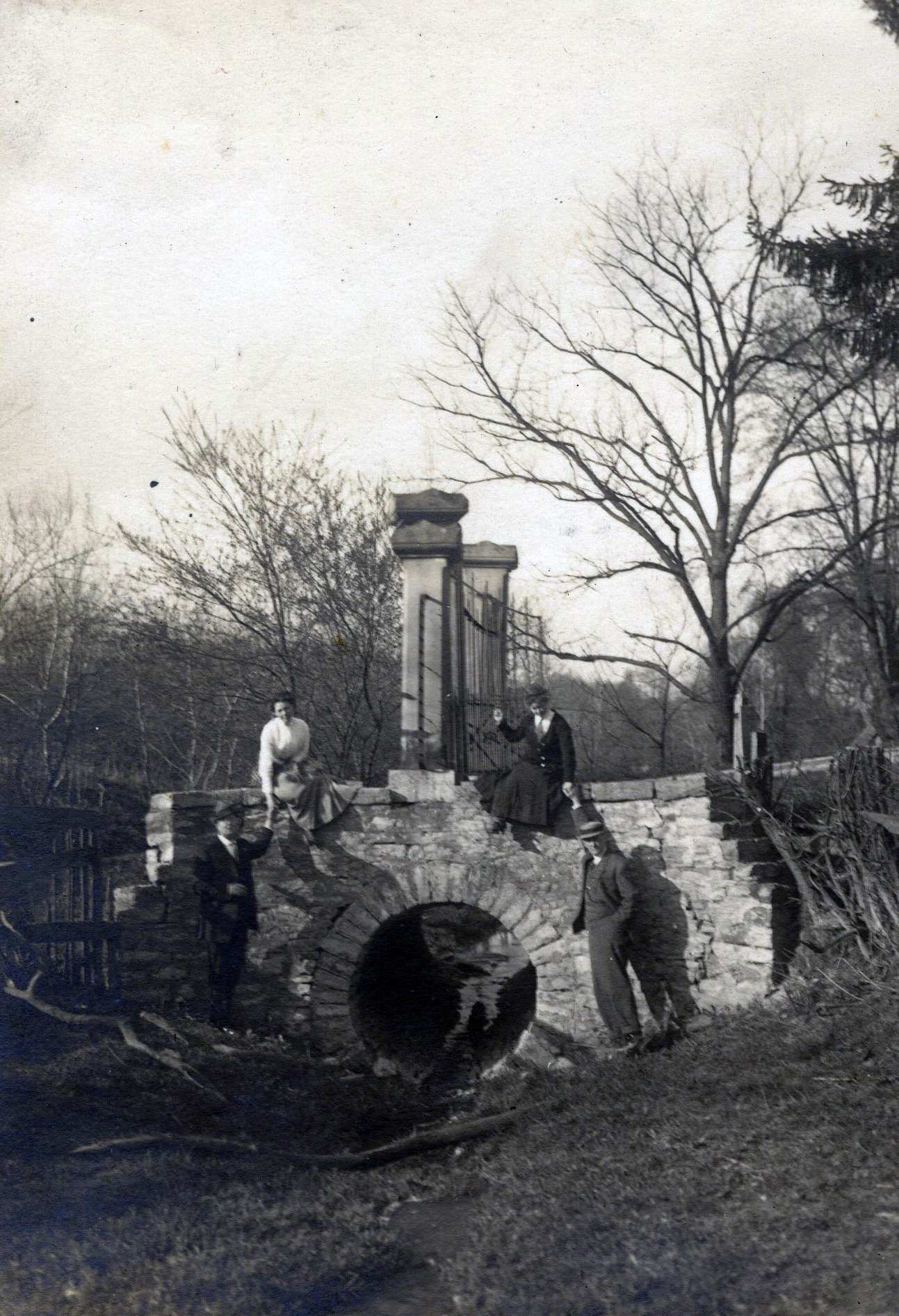
Presumably an entrance to the Dunham Hospital grounds, circa 1910.
This photo serves as a link to more information about the Dunham and other Recreation Centers around Cincinnati.
Dr. Rockhill was appointed superintendent of the hospital when it became a separate institution from the General Hospital (the present day University Hospital) on January 1, 1912. In 1912, Dr. Rockhill also recommended the construction of Solaria – sleeping porches – which were consequently added to Building No. 3.
In November, 1911, as the result of a campaign conducted by the Anti-Tuberculosis League, the citizens of Cincinnati at general election, authorized the issue of $350,000 worth of bonds, for the purpose of further extending and improving the institution. After construction, as of 1920, the hospital had a capacity of around 450 beds.
Besides the hospital buildings, there were lodgings for nurses and for doctors at the hospital, as well as an Occupational Therapy building, a Preventorium for children of patients, and a school where they attended classes. In 1927, Hamilton County took over operation of the hospital. – Julie Hotchkiss, “Day 26: Price Hill’s Dunham, From Tuberculosis Hospital to Recreation Center”
After Hamilton County gained control of operations, The Branch Hospital became known as the Hamilton County Tuberculosis Sanatorium.
The Sanatorium was then renamed again in 1945 to be referred to as Dunham Hospital in honor of Dr. Henry Kennon Dunham – “one of the country’s leading researchers into the causes and cures of tuberculosis” (Julie Hotchkiss, “Day 26: Price Hill’s Dunham, From Tuberculosis Hospital to Recreation Center”). Fifteen years previous, Dr. Dunham had been elected president of the association and had since been addressing the organization’s various issues – some of which had become financial in nature. In an interview with Isadore Sharon, Dr. Herman J. Nimitz recalls Dr. Dunham’s dedication and leadership at the hospital and how he gave time to read every patient’s x-rays at the hospital.

3D Slide of Dr. Herman J. Nimitz (ca. 1955), courtesy of Charles Lambert Rich, MD.
This image serves as a link to the blog, “Remembering the University of Cincinnati’s 25th General Hospital of WWII.”
Indeed, Dr. Herman J. Nimitz had been a resident physician at the hospital until replacing one Dr. Bishop as president of the institution all when it still retained its older name: the Hamilton County Tuberculosis Sanatorium/Hospital. Dr. Nimitz recalls in the same interview the limited treatments of the time: particularly Streptomycin and Isoniazid (antibiotics) as well as Phrenic Nerve crushes and Thoracaplasty (procedures).
Dr. Dunham later became relatively famous for describing what he referred to as a ‘fan’ within the lungs of pulmonary tuberculosis patients. This ‘fan’ consists of a solidified segment of the lung that he identified as a definitive symptom of the disease.
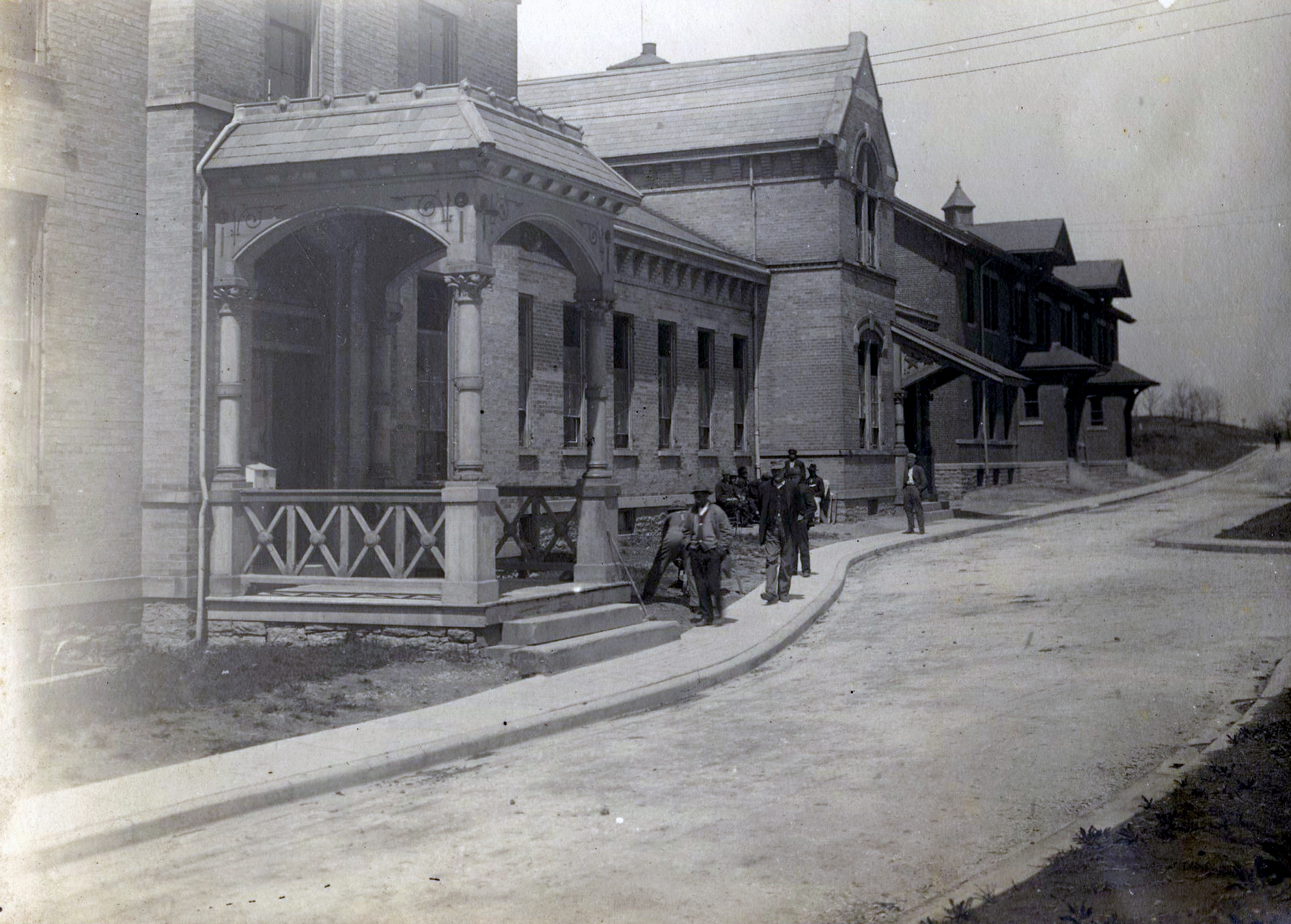
One of the Dunham Hospital Buildings. This image serves as a link to an Examiner article about the Dunham Hospital Recreation Center.
The cure for tuberculosis though, was eventually discovered in the 1940’s. The number of patients at the hospital declined. By 1967 the total had decreased to around 200 patients; in January of 1971 the decision was finally made to close Dunham Hospital as a tuberculosis treatment hospital; “[t]he last patient left in June of that year, and the property reverted from the county back to the city of Cincinnati.
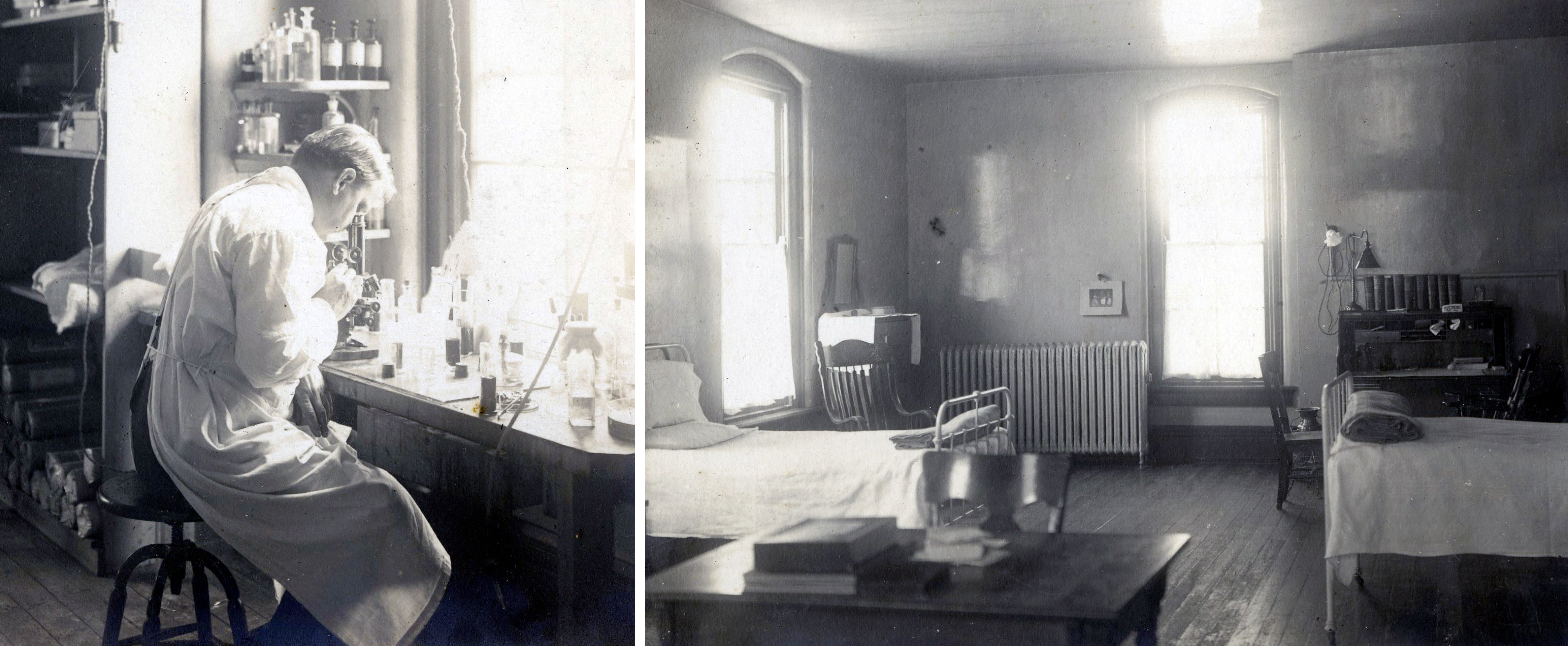
A Physician presumably researching pulmonary tuberculosis (left). Presumably a resident room in one of the Dunham Hospital buildings (right). This images serves as a link to an Examiner article about the Sunset Players Group.
Amidst numerous suggestions for uses of the land, the people of Price Hill chose to make it recreational and many of the Dunham Hospital buildings were demolished; others, completely abandoned; still others – like the Nurse’s Dormitory and the Occupational Therapy Building were refurbished for the community’s benefit.
In particular, Dunham Hospital’s Occupational Therapy Building came into use by the community theater organization known as the Sunset Players Group. Exempting a brief period from 2011 through 2012 – when the building was damaged and under repair – the Sunset Player Group has used the auditorium there since 1980.
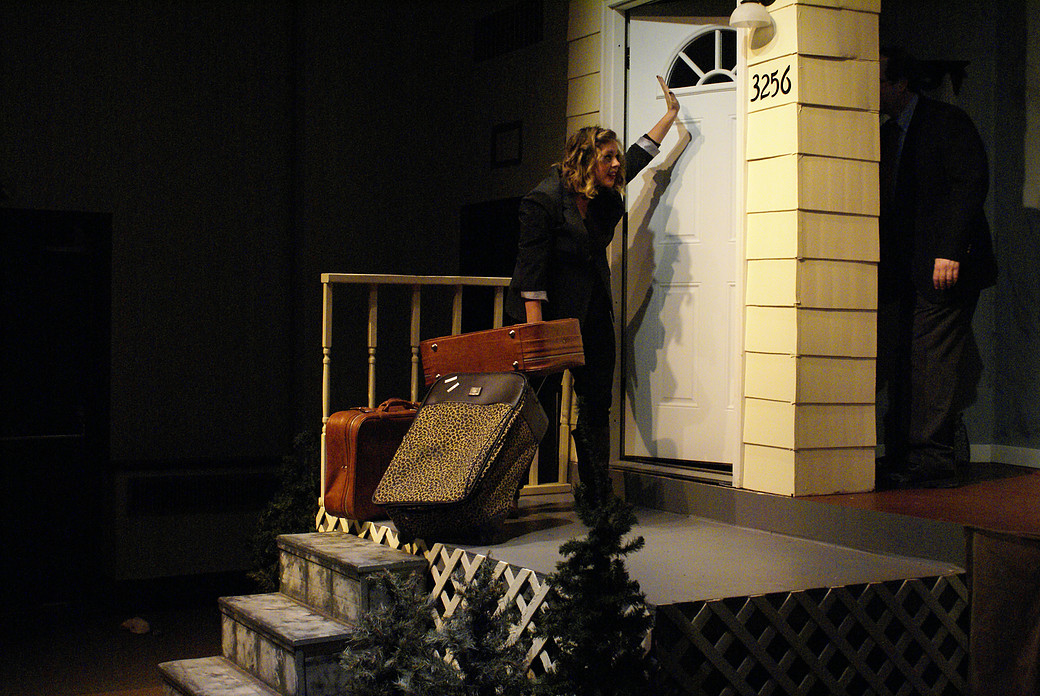
Sunset Players Group. Not to be confused with the Sunset Theatre Group. Image courtesy of the Sunset Players Group. This image serves as a link to more information about the Sunset Players Group.
Unfortunately, according to some sources, a lot of debris – including what might be considered medical waste – still exists especially around the abandoned structures of the Dunham Hospital Sanatorium. Moreover the various remnants and vestiges of the Dunham Hospital have convinced some that the area is haunted or otherwise ‘creepy.’ Any close up examination of the abandoned remains of Dunham Hospital though, spectral or otherwise, requires express permission from various community authorities.
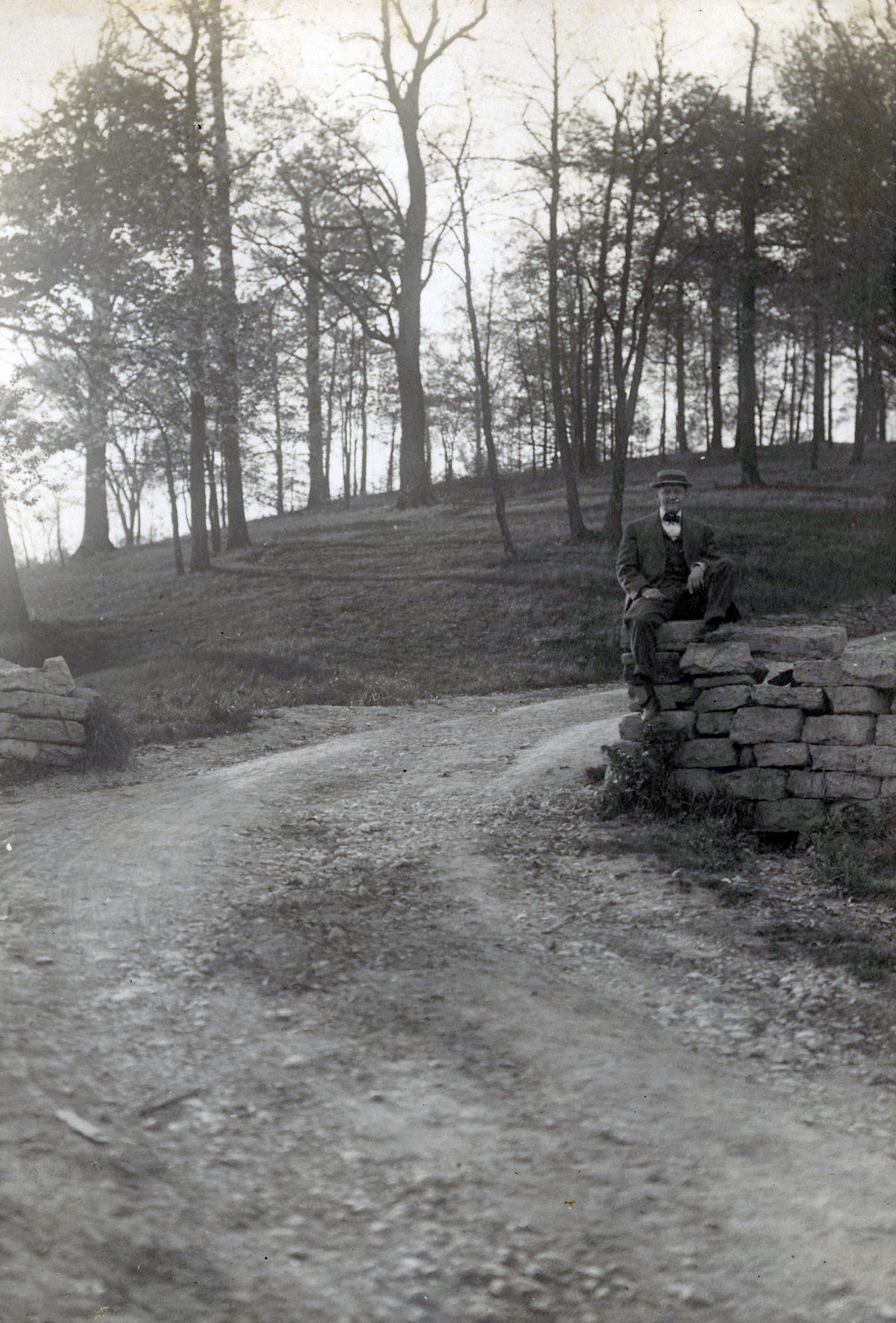
Dunham Hospital grounds, perhaps near the entrance. This image serves as a link to Creepy Cincinnati, a blog site that speculates on Dunham Hospital’s spookiness.
Regardless, Dunham Park currently features a pool, golf course, various classes and programs, as well as numerous other public attractions across approximately 115 acres.
For more information, to view a collection, or for a tour of The Winkler Center, please call 558-5120 or email chhp@uc.edu to schedule an appointment.

